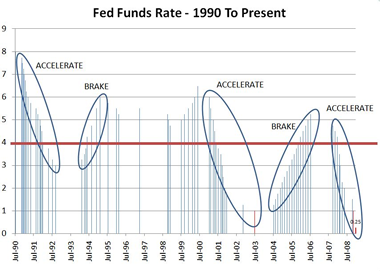Extreme Temperatures - Where's the Global Warming?
SEARCH BLOG: GLOBAL WARMING
PLEASE SEE http://hallofrecord.blogspot.com/2009/01/where-is-global-warming-extreme_19.html FOR UPDATED MATERIAL
I was looking at our local temperature history and noticed that most of the record high temperatures over the past 70 years were between 1980 and 1990 or between 1950 and 1955, while the record low temperatures were fairly evenly distributed. This graphic shows the 12 months' (not individually identified) record high temperatures and the year that they occurred. Click image to enlarge.
ADDENDUM:
On the recommendation of Dr. Roger Pielke, Sr. at the University of Colorado, I created a database from the data shown on the state charts below for all 50 states from 1884 to May 2004 (end of available data from that source). [Also see further explanatory notes regarding these data on tomorrow's post]
This is what it shows (click on image to enlarge):

The chart plots the number of record high temperatures by year for all 50 states. There is a 10-year trendline to help smooth out the data. It clearly shows that, for the U.S., the last 10 years were really no hotter than average (600 data points in 120 years = 5 per year) in creating record high temperatures. It might be worthwhile to take a look at other land masses in this way.
Dr. Pielke also requested another chart showing the low extremes which is shown below.

My comments to Dr. Pielke concerning these data were:
I'm not exactly sure how one might interpret the results of the low temps. Certainly, the 60s through the 80s had their share of record cold with the moving average of about 7-8 per year. The last ten years has seen the moving average fall toward the overall per year average of 5 (600 data points / 120 years).The work file with the database and charts will be available at Climate Science soon if you wish to exam it or use it to compare with other data. For now, it is nothing more than the raw data with two summary charts that raise some questions.
There has been greater variability (range) on the record high side (30 in 1936) than the record low side (18 in 1917) overall.
How any of the data can substantiate "global warming" is a little beyond me, I'm afraid. There is not a convincing trend of extremes to support the contention that the beginning of the 21st century is markedly different from, say, the 1950s. If the contention that the number of extremes on the high side should correspond to the change toward a hotter climate is correct, then the evidence is not there... or at least apparent to me.
Perhaps the notion that the "global warming" effect is more on the low side (few low extremes) might be hinted at with what is shown, but I wouldn't be comfortable with just a few years at the end; I'd want a couple of decades of low [few]/no low records to support that.
************
Below are the samples from various states representing regions of the U.S. that I mentioned earlier.







Records by state at Infoplease.com Source: National Climatic Data Center, National Oceanic and Atmospheric Administration.
Sorry, but I just don't see "global warming" in these extremes. It must be happening on some other part of the globe. CO2 is just not doing its job.








